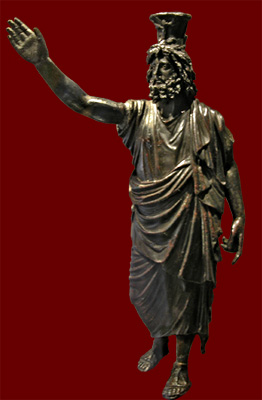
As you enter the Temple of Serapis opposite the Temple of Isis at the end of the Northern Courtyard, you are struck by how much the statues of this god resemble those of Jupiter or Zeus, except for the headdress which appears to be a modius, a basket-shaped container for grain (appropriate, you think, because Egypt is a major supplier of grain to Rome). You remember that Serapis is actually a synthetic god, created by Ptolemy after the conquest of Egypt by Alexander the Great, when the new rulers felt the need to blend their own gods with the deities of Egypt. The name Serapis is a combination of the sacred bull-god Apis and Osiris, brother and consort of Isis, who was killed by the evil god Set and partially restored to life by Isis. Since Osiris was the judge of the dead, the Ptolemies assimilated him to Hades, brother of Zeus and lord of the underworld; thus his statues resemble those of Pluto and he is often accompanied by the three-headed hound Cerberus. Although Serapis became an important god in Hellenistic Egypt, in Rome he is most frequently associated with Isis and secondary to her cult (the two deities even appear on jewelry, such as this serpentine gold ring.